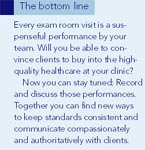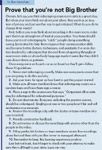Smile! You're on clinic camera!
Videotaping in the exam room may make everyone nervous at first. But strong communication skills get clients on board with the best care. And this tool can help.
You have no idea how much you and your team can learn from videotaping and reviewing exam room visits. I closely watched a veterinary student as she saw her exam room work on videotape. We watched the entire visit from the moment the client entered the exam room to the time she walked out, about 90 minutes. While she watched the video, I snuck glances at her. She was startled by what she saw.

Mark Opperman, CVPM
In the video, she leaned back against the exam room counter with her hands in her pockets and almost never made eye contact with the client. She came across as unsure and indecisive. She would say things like, "Well, I think you should ... " or "It might be ... " or "You might want to consider ... ." To make matters worse, she said "uh" 37 times.
Her professor was kind and really didn't have to point out any of these things; she noted them all on her own. She was embarrassed but thankful. She had no idea she was communicating so poorly. She worked really hard to improve her communication skills and went on to become an exceptional veterinarian.

The fact is, you probably escaped from veterinary school with little or no training in exam room communication. Fortunately, this is changing. Many schools now teach communication skills. Some even videotape students during clinic rotations and review the tapes with the student to talk about body language and tone of voice, and to share other insights about how to present healthcare information effectively.
I've worked with students during this process, and the results are impressive. The students are initially apprehensive, but after they've done it once, they positively beg to be videotaped again to see if they've improved and to receive constructive feedback. After all, where else are they going to learn these skills if not in veterinary school?
Well ... maybe in your clinic.
Watch and learn
Videotaping in the exam room is not a covert operation. The owner or manager informs all hospital employees in writing and asks them to sign a release form acknowledging that outpatient office visits may be recorded for educational purposes. Your team posts a sign in the exam room to inform clients of this as well. And only then do you install cameras. No one knows when the switch will be turned on—but they do know it'll happen.

The bottom line
When I've helped practices do this, I sit down separately with the doctor and the team member after the visit to review the tape. I'm still surprised at how effective it is. For example, one assistant repeated herself nine times during an outpatient office visit, but had no idea she did it.
During this review, you'll look for ways to cover the same information more efficiently and communicate more clearly with the client. Besides looking at what you and your team members say, you'll look at your body language and tone. Often, what you say is not as important as how you say it. And it doesn't take a lot of videotape reviews to see big changes.
When doctors don't wanna
Now, veterinarians, you tend to be more hostile to videotaping than technicians or exam room assistants, but the results you can see are just as startling. One associate I worked with was having trouble increasing her average client transaction. We had talked about making sure she offered all the products and services the pet needed, working effectively with her exam room assistants, improving her communication skills, and using passive marketing. Nothing seemed to work.
Finally, we videotaped several of her exam room visits. We then sat down together and watched the tapes. She wasn't doing anything we had talked about. In the visit, she made noncommittal statements instead of direct recommendations. I didn't have to say a word to her when the tape was done. She just sat there looking at the monitor. Finally she asked, "Who was that?"

Prove you are not Big Brother
"That was you," I said, and we both laughed.
She thought she was doing the things we had discussed, but she didn't know how. So she unconsciously fell back into old habits. Once she saw the problem, she was much more open to working on it. This associate went on to increase her average client transaction by more than $37 in the next few months, and she better served her clients and patients in the process.
All eyes on the client
Other benefits have come from videotaping sessions—some expected, some not. For instance, most cameras or digital setups display an electronic clock on the screen, so you can see how long the client sits in the exam room before the team member enters. We've timed how long the team member is in the room and, of course, how long the doctor spends with the client.
But until we started reviewing tapes, I hadn't thought much about what happens while the client is alone in the exam room. In one instance a client went through the drawers and opened all the cabinets. I'm not sure what he was looking for; fortunately he didn't take anything.
More times than not, the client will stand up in the exam room and read the wall posters and educational materials available. I've always said that anything posted on the exam room walls should be professionally framed and hung attractively, but I never imagined how many clients actually read this information. After seeing the videotapes and realizing this, several practices have created educational bulletin boards that they change each month.

Shopping list
Alternatives to tape
If you don't want to install video cameras, there are other ways to improve your team's exam room communication skills. Some practices schedule doctors to shadow other doctors during the day. The shadow doctor acts as an exam room assistant during the outpatient office visit.
The lead doctors introduces the shadow doctor by saying something like, "Dr. Smith will be assisting me today." Surprisingly, clients never question this. After the visit the two doctors sit down and discuss what occurred. Again, the results are incredible. You and your colleagues can give each other great advice on how to improve your communication skills and body language.
Another unexpected benefit is that shadowing helps establish standards of care. Doctors see how other doctors recommend procedures and at what stage of disease they're making particular recommendations. Doctors also see how their colleagues recommend products and procedures or present medical care plans to clients in a positive manner.
You cannot be afraid to open the exam room to scrutiny. This area of the practice is too important to leave to blind trust, and everyone wants to be the best they can be. But almost everyone needs help getting there.
Finding ways to get that help—whether your team chooses to record or shadow in the exam room—gives every doctor and team member an opportunity to refine his or her approach to exam room communication. What's more, this step will improve the care you give pets and enhance clients' satisfaction.
Veterinary Economics Hospital Management Editor Mark Opperman, CVPM, is owner of VMC Inc., a veterinary consulting firm in Colorado. Catch his practice management seminars on interviewing, retaining, training, and motivating team members Oct. 23 at CVC West. For more information, visit cvcwest.com. Send questions or comments to ve@advanstar.com